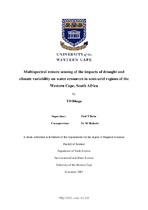| dc.contributor.advisor | Dube, Timothy | |
| dc.contributor.author | Bhaga, Trisha | |
| dc.date.accessioned | 2022-01-19T08:49:33Z | |
| dc.date.available | 2022-01-19T08:49:33Z | |
| dc.date.issued | 2021 | |
| dc.identifier.uri | http://hdl.handle.net/11394/8612 | |
| dc.description | >Magister Scientiae - MSc | en_US |
| dc.description.abstract | The occurrence of droughts is a threat to global water resources and natural ecosystems, with the impact being more profound in semi-arid environments. The frequency of droughts is likely to increase because of climate change, and this poses a huge threat to the available water resources, to livelihoods and to ecosystems. Routine drought monitoring is fundamental for developing an early warning system and an area-specific drought mitigation and adaptation framework. Surface waterbodies, especially those in arid and semi-arid environments, are vulnerable to the impacts of drought. The development of moderate-resolution sensors, such as the Landsat 8 Operational Land Imager (OLI) and the Sentinel-2 Multispectral Instrument (MSI), allow new opportunities to monitor droughts and their impact on surface waterbodies. | en_US |
| dc.language.iso | en | en_US |
| dc.publisher | University of Western Cape | en_US |
| dc.subject | Climate change | en_US |
| dc.subject | Drought | en_US |
| dc.subject | Evapotranspiration | en_US |
| dc.subject | Satellite data | en_US |
| dc.subject | Surface waterbodies | en_US |
| dc.title | Multispectral remote sensing of the impacts of drought and climate variability on water resources in semi-arid regions of the Western Cape, South Africa | en_US |
| dc.rights.holder | University of Western Cape | en_US |

